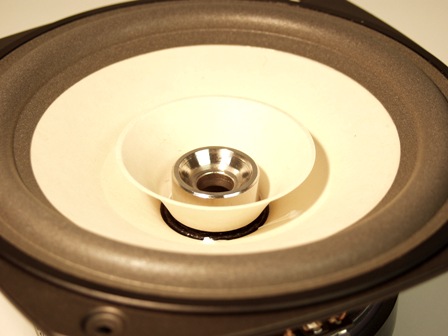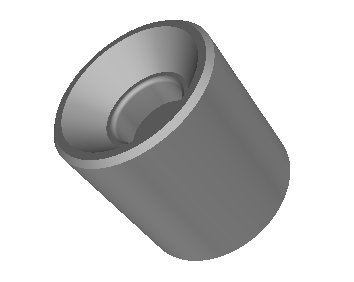|
PRINCIPLE OF THE DECWARE PHASE GUIDE NOV 2003 Our new High Definition Tower speakers are using a modified Fostex full range driver, model FE206E. A respectable sounding driver in it's stock form, a giant killer with the proper modifications. It comes stock with a whizzer cone and vented dust cap. On more expensive speakers that reproduce mid and high frequencies it's common to find what is typically called a "phase plug" located in place of the dust cap. The bullet shape of the plug is designed to reduce the inherent phase cancellations that occur between the dust cap and speaker cone. By reducing the phasing issues at these higher frequencies it is possible to improve and flatten frequency response. From a more subjective perspective it helps add depth and clarity to the sound stage with less beaming. Many Lowther and Fostex type full range drivers also use phase plugs of some sort to accomplish these goals. Some have whizzer cones to extend high frequency response above 8K, some do not. Either type will be effected the same by the addition of a phase plug. The the only modification would be to the shape of the plug itself to better compliment the steeper angle of the (whizzer) cone. You will notice many variations on the shapes and application of phase plugs, especially if you look at Lowther speakers. What makes this different is a small hollow cavity that resonates. The resonance only happens at mid-range frequencies (where it's needed) and by resonating it creates a pressure node at the tip that acts as a wave guide that varies in shape with the music.
The hollow reservoir resonates to create high and low pressure nodes at the tip.
In the illustration above, you can see a cross sectional view of the main components involved with the application of this device. They are as follows: A) Stock steel pole piece that it attaches to. B) The voice coil bobbin that it sets inside. C) Shown in red - the phase guide itself. G) The speaker cone. The phase guide displaces the dead air space above the pole piece. This area above the pole and between the inside walls of the bobbin create the same effect as an empty silo in a barn yard. If you walk inside the empty silo and play music, the reflections make it hard to understand what you're listening to. There are two ways to correct the reflections inside an empty silo. Extensive modification to it's shape and absorbing wall treatments or fill the silo. By filling it you reduce the air and the distance between surfaces to a point where there is little or no sound.
The high frequency energy (resonance) created by the voice coil that is not absorbed by the cone travels along the surface tension of air laying on the phase guide. The high pressure of air molecules that form on the surface of the phase guide create a skin effect or surface tension that acts as bending wave transducer. Put a different way, the energy from the voice coil bobbin uses the surface tension found on the phase guide as a bending wave transducer. This is illustrated in D) of the above picture. This wave guide offers organization and stability to the air molecules that are bending across it's surface. When the energy reaches the end of the phase guide it launches off the rim into the air and out into the room. Since the phase guide and it's rim are fixed and solid, they do not move. In part E) of the picture above you can see this makes for a solid platform for the energy to launch from. (Aids in the linear projection of sound) The alternative is removing the phase guide and allowing the energy to launch of the chaotic end of the voice coil bobbin, a point that moves. This is the weak spot with most moving coil speakers that do not have the voice coil bobbin trimmed perfectly flush with the cone. Anything that sticks past this point resonates with ugliness. The dust cap is often used to block this nasty sound from being heard. The most interesting part of the Decware phase guide is how the hollow cavity modifies the actual shape of the plug as it relates to the dispersion or organization of sound waves. Specifically the shape or tip of a phase plug determines how well it corrects the phase errors between the cone and the plug. With this phase guide, the hollow cavity resonates just as any Hemholtz resonator would, with the frequency and Q determined by the length, diameter(s) and port. (See part F) At frequencies that are below resonance, the air pressure at the tip is zero making the shape of the tip true to it's physical dimension - flat. At higher frequencies, the piston of air in the cavity will resonate creating an alternating high and low pressure at the tip. When the pressure is high, the tip takes on the shape of a bullet with respect to low pressure around it. This in turn sets up a wave guide for the sound that surrounds it. This means that the shape of the tip is constantly being modified in real time by the sound itself. That translates into different phase angle correction at different frequencies! Hearing is believing. When you compare a fixed plastic non-hollow phase plug to this it is easy to realize that the fixed bullet shape will only modify phase angles one way. The angles will be ideal for some frequencies and less than ideal for others. To demonstrate this, you can take some gum and cover the opening of the Decware phase guide and listen. It won't matter if you make gum hemispherical or bullet shaped or even flat. If you plug the hole you will hear a significant reduction in high frequency extension and clarity when the opening is blocked. You can even do this with you finger. Unblocked, the sound is wonderfully more open with noticeably better detail in the top end. You can amaze yourself for hours by going back and forth. I worked on tweaking the Fostex driver for about 3 days. The majority of attention was on finding the right phase plug to replace the dust cap. The time was spent trying every shape and style phase plug I could make or find, including the very light bulb I used to see by. This is when I came up with the Decware phase guide. This is the primary modification that we make to the Fostex FE206E driver. I have also done this with other drivers both with and without whizzer cones and get consistent results with all of them. In listening to test drivers with conventional phase plugs, this phase guide was very audibly superior. In practice it is also superior because you don't have to try to computer model the ideal shape for any given cone geometry. The only variable with this design is length which must be determined for each application. As for it's altering the magnetic properties of the pole which is obviously going to change the shape of the magnetic flux in the gap and alter driver specs, so far no negative effects on the sound could be detected. If the alteration of these specs actually makes the driver sound better then it stands to reason there will be a driver somewhere that will react in a negative way. My observations so far indicate the change is minimal. Some may notice that the opening to the hollow cavity in the phase guide is actually square. The interior of the cavity is round. This eliminates the standing waves that would otherwise rest between the two parallel rims and cause problems with everything else.
Steve Deckert
This technology is used in our High Definition Tower speakers that are ideal for lower power SET amplification. Listening tests were focused around our signature loudspeaker, the HDT starting with the stock FE206E drivers. While the HDT cabinet design goes a long way to maximize the Fostex drivers performance it still wasn't perfect when compared to our reference full range tube driven electrostats. There was still a touch of dryness and beaming in the mid-range. The top end sparkle made famous by the electrostatics or even a good pair of ribbon tweeters simply did not exist. In fact I found myself frequently thinking that adding a ribbon tweeter at 10K would really make the FE206E's sound great. After modifying the drivers with the phase guide, the dryness went away, the beaming and slight shout in the mids vanished, and the high frequencies extended higher than I can hear. I listened for many weeks and the desire to add a ribbon tweeter went completely away. I honestly believe this modded driver sounds more musically correct and has far flatter and more accurate frequency balance than most if not all Lowthers. I also estimate that the new PM6A if modified with this same phase guide would also impress me. The PM6A is the only Lowther driver I like well enough to live with, but they cost a bunch. I think our modified FE206E is better in enough ways that many people may actually prefer it's sound. At 1/3 the price it makes more sense for everyone.
NOTE: The FE206EM has now been improved and is called the DFR-8 UPDATE on Phase Guide - Aug 2006
Many people have been starting to want these phase guides to become available for sale so they can modify their own drivers. This will now be possible as a result of this latest improvement.
Decware is a trademark of High Fidelity
Engineering Co. |



